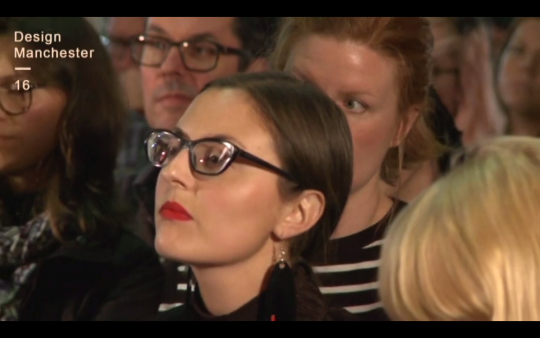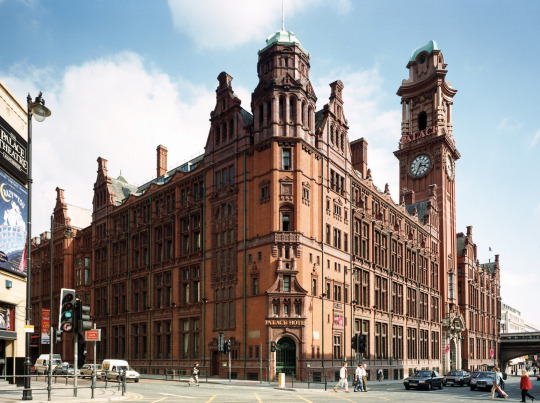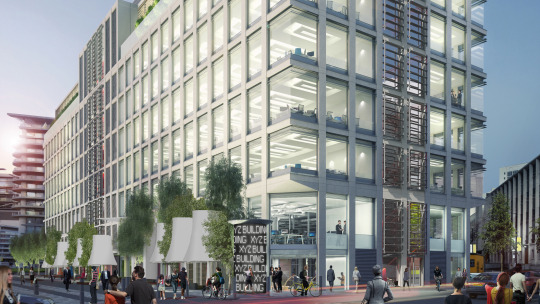Why Enterprise City UK is important for all of Manchester, not just the creative entrepreneurs who will make it their base.

Roundtable discussion at the launch of Enterprise City UK at Old Granada Studios, Manchester, 26 April
On Monday last week, the Washington Post carried a headline that read: “This guy convinced cities to cater to tech-savvy millennials. Now he’s reconsidering.”
The article was about one of the fathers of design thinking for cities, Richard Florida, whose book The Rise of the Creative Class influenced the development of creative and tech hubs in cities all over the world.
In his book, Florida had argued that cities in the automated digital world should attract the best young talent in computer programming, engineering, finance, media and the arts so they could grow their economies based on the venture capital and start-up companies the new workforce would produce.
So what was the Washington Post article about? Richard Florida hasn’t suddenly gone anti-tech or anti-city. But he does highlight some things for us to think about. What he came to realise was that there were unintended side-effects. “In places like New York, San Francisco and Seattle,” the article pointed out, “the mostly white, young and wealthy “creative class” has so fervently flocked to urban neighbourhoods that they have effectively pushed out huge populations of mostly blue-collar and often poor or minority residents.”

Zoë Hitchen at Design Manchester’s Great Debate in October 2016: how do we keep the city accessible for new talent?
In other words, their success made their neighbourhoods so expensive that diverse, mixed communities – and poor young artists for that matter – could no longer afford to live or work there. That’s also true of parts of London today and in the Design Manchester public debate that took place in the Bonded Warehouse at St John’s last October, Zoë Hitchen of the BBC User Experience team and the Manchester Fashion Institute raised the same concern for Manchester: how do we keep it diverse and affordable as we become even more successful? At our Great Debate a year earlier at The Whitworth, the architect Dominic Sagar, one of the founders of the Northern Quarter, had made a similar point. Investment in the city is welcome, he said, but “we don’t want to become Brandchester or Blandchester and have our spirit squashed.”
In his new book, The Roots of the New Urban Crisis, Richard Florida now says that the clustering of talent and economic assets “generates a lopsided, unequal urbanism in which a relative handful of superstar cities, and a few elite neighbourhoods within them, benefit while many other places stagnate or fall behind.
“Ultimately,” he adds, “the very same force that drives the growth of our cities and economy, also generates the divides that separate us and the contradictions that hold us back.” Florida blames Brexit and Trump on such growing divides.
The rise of the creative class – not the book, but the trend – has delivered rapid growth and progress, but also problems of division.
So what is the answer?
It is to design balanced cities and a balanced economy that offers opportunity, prosperity and safety for all.
The trick is to boom and yet remain diverse, inclusive, open and connected, with affordable housing, good education and a safe public environment, so that the city can continue to attract people, families, business and investment.
The trick is to make sure we have not only a vibrant neighbourhood but a vibrant city and a vibrant region. Developing exclusive, unaffordable bastions is not the strategic vision of the city or the region. In theory at least, the Northern Powerhouse, with its balanced economy thinking, is intended to deliver a more well-rounded and inclusive outcome.
Enterprise City is a catalyst in a bigger picture. It can help to build the pathways and foster the wider collaboration with people and startups and networks throughout the region that are essential to the success of Manchester as a whole.
Enterprise is creating things and making a success of it, so as a concept, Enterprise City is very well suited to a city where talent and industry are as abundant as they are here in Manchester.
Design has a big part to play, because it is at the heart of creative endeavour.
Design is how we connect technology to its users. It is how we make a city work for its residents and visitors. We use design to turn scientific inventions such as graphene into usable products. We design great spaces – and if spaces aren’t great, it’s because they’ve not been well-designed.
Through clothing and graphics and cars and furniture and gadgets – and trainers, design allows people to express their own style and individuality. Design helps people understand information and it helps them to communicate with one another.
Design is the human factor in technology, in enterprise and in cities, because the purpose of design is to think about the user and to provide for the user.
The icons of the digital age – Google and Apple and Facebook – have demonstrated time and again that successful digital enterprise has design at the heart of its thinking and its practice – not only in their products but also in their workspaces and in the cities and districts where they choose to locate their offices.

In a digital world, design is the human factor that is the key to success. One of the reasons for Manchester’s great potential as a city is what Council Leader Sir Richard Leese in Document 16 called “the centrality of design to the Manchester story”.

The 2017 Design Manchester Conference will take place at The Principal on 13 October
We established Design Manchester in 2013 and from 11–22 October this year we will be holding Manchester’s fifth annual design festival. Our Design Conference, at the Principal Hotel on 13 October, is where design professionals and students can listen to some of the greatest designers from Manchester and around the world, showing some of the best and the latest in design. Our Great Debate, which took place here in the Bonded Warehouse last year, will this year be on the opening night, 11 October, with leading figures from design, the city and politics on the panel and a very well informed and opinionated audience as usual. The Design and Print Fair that took place at London Road Fire Station last year will be at Upper Campfield Market from the 20–22 October, with stalls and workshops for families and the general public. And there will be more than 30 other events including music and exhibitions, workshops, symposia and film screenings, at iconic locations throughout the city.
When we started Design Manchester, we always felt that this is a city that can sustain an annual design festival and so far we haven’t been proved wrong. We did not have to invent anything, the culture was here, the art schools are here, the industry was growing quickly. We were of course standing on the shoulders of Tony Wilson and his In The City festival – but he was doing it to attract the music industry to Manchester. These are the reasons that Enterprise City will succeed: firstly because the culture and the talent are here, and secondly because this will help attract different skillsets and finance into the mix.

Green and healthy: Sean Anstee and Andy Burnham make their pitch
Labour’s Mayoral candidate for Greater Manchester, Andy Burnham, talks about a “digital city” and a “green city”. His Tory opponent on 4th May, Trafford Council Leader Sean Anstee, talks about a “cycle-friendly city” and a “healthy city”.
We need to look behind the labels and think about how these ideas are going to achieve their aims. The Bonded Warehouse is a great space, built during the industrial revolution – and now all about innovation. For Enterprise City, is it about spaces like this? We love buildings, buildings are important, but a modern city is not primarily about buildings, or roads, but about networks. Future cities are about people, about how they connect, interact and transact.
Enterprise City knows this. As Mike Ingall said last year, Enterprise City “is about creating so much more than just buildings. It is about providing infrastructure and inspiration so businesses can realise their full potential.”
There are many other great creative spaces and neighbourhoods in Manchester, some old and some brand new, that are all about looking to the future.

The XYZ Building (Cartwright Pickard)
In Spinningfields there’s the amazing XYZ building, also part of the Enterprise City initiative, with its fintech hub and great events, designed by Cartwright Pickard. There is The Sharp Project, a disused old electronics factory, transformed by PRP Architects into a digital content hub with more than sixty companies making it their home – and of course with a great brand and wayfinding by Malcolm Garrett. There’s the BDP-designed Innovation Centre in Manchester Science Park, part of Cisco’s National Virtual Incubator.

The Pilcrow (OH OK! LTD)
There’s the Pilcrow Pub and the new PLANT maker-culture workshops and exhibition space at NOMA created by OH OK! and co-designed with the local community. There’s the new Circle Square being built on Oxford Road; and Manchester Metropolitan University, which has its great digital innovation centre at The Shed, will soon be launching its new International Screen School.
Then of course there’s the Northern Quarter, still edgy and still vibrant — and even the tram stops on St Peter’s Square are becoming usable again.
There is a huge amount going on in the city centre and there are great examples in the wider city region too, from Media City at one end of the scale in Salford to the artist studios in Islington Mill at the other, and great new regeneration projects like Oldham Town Hall and Tameside Mill.

Oldham Town Hall (BDP)
We should look for productive ways of building collaborations between these hubs and spaces and the people and businesses in them to provide a wider range of talent and expertise into what we produce and to build better opportunities for, and supplies of, the talent that we need for our industry and our city to grow.
In Manchester, the Creative & Digital sector is one of the fastest growing drivers of the economy. And across all sectors, of all the economic success stories in the last five years, 87% had ten or fewer employees and were established for between three to five years. (New Economy) So, the biggest engine of growth in Manchester is (1) creative and digital, and (2) new startups.
Creative Review reports in its May issue that more than half of the respondents to its Creative Workplaces Survey identify themselves as being part of the ‘design industry’.
The supply of talent to this engine of growth is one of the big challenges we face. If the outcome of Brexit is that in three years’ time the door closes to recruiting new talent from southern and eastern Europe, that will be a critical problem for the tech industry which could result in a massive talent drain to London, which will certainly spend to attract talent from elsewhere in the UK. We may be growing quickly, but according to Tech City UK, the tech sector in London has more than 300,000 digital jobs currently, and that’s expected to rise by nearly 20% in the next decade. Manchester currently has 63,000 digital jobs. We are in a good position but there is no room for complacency.
This is just one of the reasons why Enterprise City, as part of a holistic strategy for Manchester, is important. To maintain our momentum we need in the next couple of years to significantly increase the number of skilled and talented people who see Manchester as the best option to make their careers: a liveable and affordable city where talent and ingenuity can succeed as well as, and in some respects better, than elsewhere. We do that with infrastructure, policy and narrative, and Enterprise City feeds into all three.
In short, Enterprise City is a great opportunity for creative and entrepreneurial talent, not as the privileged zone separated from less advantaged parts of the city that Richard Florida refers to as the “new urban crisis”, but as a collaborative and open catalyst for growth, with mechanisms to ensure it is connected with other initiatives across the region and with opportunities for continued participation in the mix by new talent, new artists and entrepreneurs – not as employees but as startups and individuals who can’t yet afford high rents but will offer a continued edge of disruption, new thinking and unexpected opportunity. In this context, Project Forward is a fantastic asset for Enterprise City, promising a steady supply and incubation of talent in the creative digital area.
Design can help by supporting incubation and by looking at how Enterprise City is connected to the wider region – and to the food chain that takes raw talent to successful enterprise.
The City, the new Mayor and the Government can support a holistic approach by addressing the barriers to entry, for example by encouraging and supporting more women and diverse communities into the creative & digital sector, by ensuring that creativity, including art and design, are given priority alongside STEM subjects in education and particularly in skills training so that the creative industries have access to the right skills to grow and so that young talent in the area can develop careers that are not going to disappear in the coming wave of automation and artificial intelligence.
The Creative Industries Federation published an excellent creative industries manifesto for the general election yesterday which describes creative employment as resistant to automation and demands that to be eligible for an Ofsted Outstanding rating, a school must teach at least one creative subject, in lesson time.
We should develop mentoring and support programmes within Project Forward and Enterprise City – to inject and support design thinking in the emerging startups, and to develop sector–specific design skills in growth areas such as fintech, cybersecurity, fashion, textiles, screen and many other areas. As Design Manchester we will be keen to help connect Enterprise City to the wider design community in Manchester for mutual benefit, and so that we can all collaborate together to embed design thinking throughout our city.
We practise what we preach, working with our partners the Co-op on schools programmes for creative careers, and with universities and industry on opportunities and pathways. At our festival in October – in addition to the Conference, the Debate and the Design Fair – we will have a wide range of workshops and symposia for different audiences, from architects and professional designers to kids who want to learn coding and design, and sessions on age-friendly design, print techniques and much else besides.
Design, partnership, collaboration, connection and inclusion are key to the region’s success. This is why Design Manchester welcomes this visionary Enterprise City project and we look forward to collaborating with it in the coming years.

